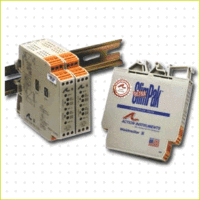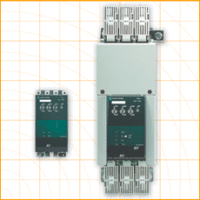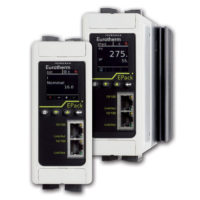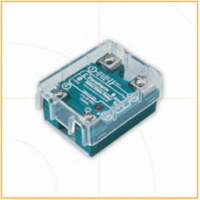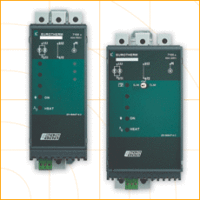Product Description
G128 Alarm
G128 Alarm
The Ultra Slim Pak G128 is a DIN rail mount, thermocouple input limit alarm with input terminal cold junction compensation (cjc), dual setpoints and two contact closure outputs. The field configurable input and alarm functions offer flexible setpoint capability. There are up to six temperature ranges available for each thermocouple type to ensure accuracy and maximize setpoint resolution. A bipolar input switch is provided for temperature ranges below 0°C.
The G128 is configurable as a single or dual setpoint alarm, with HI or LO trips, upscale or downscale thermocouple burnout detection and failsafe or non-failsafe operation. Also included are adjustable deadbands (0.25 to 5% of full scale input) for each setpoint and a flexible DC power supply which accepts any voltage between 9 and 30VDC.
Diagnostic LEDs
The G128 is equipped with three front panel LEDs. The first is a dual function LED labeled INPUT. This green LED indicates DC power and input signal status. Active DC power is indicated by an illuminated LED. If this LED is off, check line power and wiring connection. If the input signal is more than 110% of the full scale range, the LED will flash at 8 Hz. Below -10%, the flash rate is 4 Hz.
Two red LED’s indicate the relay state for each setpoint. An illuminated red LED indicates the tripped condition.
Output
The G128 is equipped with two SPDT (form C) relays, rated at 120VAC or 28VDC at 5 amperes. Each of these relays is independently controlled by the field configurable set point and deadband.
Operation
The field configurable G128 limit alarm setpoints can be configured for HI or LO, failsafe or non-failsafe operation. Each of the setpoints has a respective HI or LO deadband. In a tripped condition, the setpoint is exceeded and the appropriate red LED will illuminate. The trip will reset only when the process falls below the HI deadband or rises above the low deadband (see Figure 1). For proper deadband operation, the HI setpoint must always be set above the LO setpoint.
In failsafe operation, the relay is energized when the process is below the HI setpoint or above the LO setpoint (opposite for non-failsafe). In the failsafe mode, a power failure results in an alarm state output.
Dynamic Deadband
LSI circuitry in the G128 prevents false trips by repeatedly sampling the input. The input must remain beyond the setpoint for 100 milliseconds, uninterrupted, to qualify as a valid trip condition. Likewise, the input must fall outside the deadband and remain there for 100 milliseconds to return the alarm to an untripped condition. This effectively results in a “dynamic deadband” —based on time— in addition to the normal deadband.
Configuration
Unless otherwise specified, the factory presets the Model G128 as follows:
| Input: | J Type |
| Range: | 0 to 350°C |
| Output: | Dual, SPDT |
| Trip: | A: HI, B: LO |
| Failsafe: | No |
| Deadband: | A, B: 0.25% |
The DC power input accepts any DC source between 9 and 30V, typically a 12V or 24VDC source is used (see Accessories).
For other I/O ranges, refer to Table 1 and reconfigure switches SW1 and SW2 for the desired input type, range and function.
- With DC power off, position switch SW1-1, 2, 3 and SW2-1 through 6 for the desired input range (Table 1).
- Set positions 4 and 5 of function switch “SW1” to ON for a HI trip setpoint or OFF for a LO trip setpoint (Figure 4).
- Set position 6 of function switch “SW1” to ON for non-failsafe operation or OFF for failsafe operation (e.g. alarm trips upon power failure).
- Set positions 7 and 8 of function switch “SW1” to upscale or downscale burn-out.
Calibration
- After configuring the DIP switches, connect the input to a calibrated TC source and apply power. Refer to the terminal wiring (Figure 5).
- Setpoint: set deadband at its minimum (20 turns counter clockwise) before adjusting the setpoint. With the desired trip thermocouple millivolt input applied, adjust setpoint until the relay trips. For HI trip calibration, start with the setpoint above the desired trip (20 turns clockwise). For LO trip calibration, start below the desired trip (full counter clockwise).
- Deadband: Set deadband to its minimum (20 turns counter clockwise). Set the setpoint to desired trip. Adjust thermocouple millivolt input until relay trips. Readjust deadband to 5% (20 turns clockwise). Set voltage/current input to desired deadband position. Slowly adjust deadband until relay untrips.
Relay Protection and EMI Supression
When switching inductive loads, maximum relay life and transient EMI suppression is achieved using external protection (see Figures 2 and 3). Place all protection devices directly across the load and minimize all lead lengths. For AC inductive loads, place a properly-rated MOV across the load in parallel with a series RC snubber. Use a 0.01 to 0.1mF pulse film capacitor (foil polypropylene recommended) of sufficient voltage, and a 47W, 1/2W carbon resistor. For DC inductive loads, place a diode across the load (PRV > DC supply, 1N4006 recommended) with (+) to cathode and (-) to anode (the RC snubber is an optional enhancement).
TECHNICAL SPECIFICATION (G128)
Inputs
- Range: See Table 1
- Impedance: >1 MegW
Input Bias
- Current (burnout detection): <1.5 microamp
- Overvoltage: ±10V differential
- Common Mode (Input to Ground): 1800VDC, max.
LED Indicators
Input Range (Green)
- >110% input: 8Hz flash
- <-10% input: 4Hz flash
Setpoint (Red):
- Tripped: Solid red
- Safe: off
Limit Differentials (Deadbands)
0.25% to 5% of span
Response Time
- Dynamic Deadband: Relay status will change when proper setpoint/process condition exists for 100msec
- Normal Mode (analog filtering): <250msec, (10-90%)
Setpoint
- Effectivity: Setpoint(s) are adjustable over 100% of the selected input span
- Repeatability (constant temp.): 0.2% for temp > 0°C 0.3% for temp < 0°C
Stability
Temperature: ±0.05% of full scale/°C, max.
Common Mode Rejection
DC to 60Hz: 120dB
Isolation
1800VDC between contacts, input and power
EMC Compliance (CE Mark)
- Emissions: EN50081-1
- Immunity: EN50082-2
- Safety: EN50178
Humidity (Non-Condensing)
- Operating: 15 to 95% (@45°C)
- Soak: 90% for 24 hours (@65°C)
Temperature Range
- Operating: 0 to 55°C (32 to 131°F)
- Storage:-15 to 70°C (5 to 158°F)
Power Consumption:
1.5W typical, 2.5W max.
Supply Range:
9 to 30 VDC, inverter isolated
Relay Contacts
2 SPDT (2 Form C) Relays, 1 Relay per setpoint
Current Rating (resistive)
- 120VAC: 5A
- 240VAC: 2A
- 28VDC: 5A
- Material: Gold flash over silver alloy
- Electrical Life: 10^5 operations at rated load
- Mechanical Life:10^7 operations
Wire Termination
Screw terminations for 12-22 AWG
Weight
0.56lbs.
Agency Approvals
- CSA certified per standard C22.2, No. 0-M91 and 142- M1987 (File No. LR42272)
- UL recognized per standard UL508 (File No.E99775)
- CE Compliance per EMC directive 89/336/EEC and low voltage 73/23/EEC.

